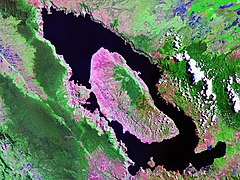Toba catastrophe theory
From Wikipedia, the free encyclopedia
According to the Toba catastrophe theory, 70,000 to 75,000 years ago a supervolcanic event at Lake Toba, on Sumatra, reduced the world's human population to 10,000 or even a mere 1,000 breeding pairs, creating a bottleneck in human evolution. The theory was proposed in 1998 by Stanley H. Ambrose of the University of Illinois at Urbana-Champaign.[1][2]
Contents[hide] |
[edit] History
Within the last three to five million years, after human and other ape lineages diverged from the hominid stem-line, the human line produced a variety of species.
According to the Toba catastrophe theory, a massive volcanic eruption severely reduced the human population. This may have occurred around 70–75,000 years ago when the Toba caldera in Indonesia underwent an eruption of category 8 (or "mega-colossal") on the Volcanic Explosivity Index. This released energy equivalent to about one gigaton of TNT, which is three thousand times greater than the 1980 eruption of Mount St. Helens. According to Ambrose, this reduced the average global temperature by 5 degrees Celsius for several years and may have triggered an ice age.
Ambrose postulates that this massive environmental change created population bottlenecks in the various species that existed at the time; this in turn accelerated differentiation of the isolated human populations, eventually leading to the extinction of all the other human species except for the two branches that became Neanderthals and modern humans.
[edit] Evidence
Some geological evidence and computed models support the plausibility of the Toba catastrophe theory, and genetic evidence suggests that all humans alive today, despite their apparent variety, are descended from a very small population, perhaps between 1,000 and 10,000 breeding pairs.[3][4]
Using the average rates of genetic mutation, some geneticists have estimated that this population lived at a time coinciding with the Toba event. These estimates do not contradict the consensus estimates that Y-chromosomal Adam lived some 60,000 years ago, and that Mitochondrial Eve is estimated to have lived 140,000 years ago, since Toba is not conjectured to be an extremal bottleneck event, where the population was reduced to one breeding pair.
Gene analysis of some genes shows divergence anywhere from 2 million to 60,000 years ago, but this does not contradict the Toba theory, again since Toba is not conjectured to be an extremal bottleneck event. The complete picture of gene lineages (including present-day levels of human genetic variation) allows the theory of a Toba-induced human population bottleneck.[5]
[edit] Migration
According to this theory, humans once again fanned out from Africa after Toba when the climate and other factors permitted. They migrated first to Arabia and India and onwards to Indochina and Australia (Ambrose, 1998, p. 631), and later to the Middle East and what would become the Fertile Crescent following the end of the Würm glaciation period (70,000–10,000 years bp).
[edit] See also
[edit] References
- ^ Stanley H. Ambrose (1998). "Late Pleistocene human population bottlenecks, volcanic winter, and differentiation of modern humans". Journal of Human Evolution 34 (6): 623–651. doi:10.1006/jhev.1998.0219.
- ^ Ambrose, Stanley H. (2005). Volcanic Winter, and Differentiation of Modern Humans. Bradshaw Foundation. Retrieved on 2006-04-08.
- ^ When humans faced extinction. BBC (2003-06-09). Retrieved on 2007-01-05.
- ^ Late Pleistocene human population bottlenecks, volcanic winter, and differentiation of modern humans by Stanley H. Ambrose
- ^ Dawkins, Richard (2004). "The Grasshopper's Tale", The Ancestor's Tale, A Pilgrimage to the Dawn of Life. Boston: Houghton Mifflin Company, 416. ISBN 0-618-00583-8.
[edit] External links
- Population Bottlenecks and Volcanic Winter
- 1998 article based on news release regarding Ambrose's paper
- Homepage of Professor Stanley H. Ambrose
- Toba Volcano, by George Weber
- Article in The Economist
- Journey of Mankind by The Bradshaw Foundation - includes discussion on Toba eruption, DNA and human migrations
- Geography Predicts Human Genetic Diversity ScienceDaily (Mar. 17, 2005) — By analyzing the relationship between the geographic location of current human populations in relation to East Africa and the genetic variability within these populations, researchers have found new evidence for an African origin of modern humans.
- Out Of Africa -- Bacteria, As Well: Homo Sapiens And H. Pylori Jointly Spread Across The Globe ScienceDaily (Feb. 16, 2007) — When man made his way out of Africa some 60,000 years ago to populate the world, he was not alone: He was accompanied by the bacterium Helicobacter pylori...; illus. migration map.






